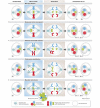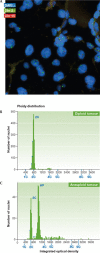Cancer chromosomal instability: therapeutic and diagnostic challenges
- PMID: 22595889
- PMCID: PMC3367245
- DOI: 10.1038/embor.2012.61
Cancer chromosomal instability: therapeutic and diagnostic challenges
Abstract
Chromosomal instability (CIN)-which is a high rate of loss or gain of whole or parts of chromosomes-is a characteristic of most human cancers and a cause of tumour aneuploidy and intra-tumour heterogeneity. CIN is associated with poor patient outcome and drug resistance, which could be mediated by evolutionary adaptation fostered by intra-tumour heterogeneity. In this review, we discuss the clinical consequences of CIN and the challenges inherent to its measurement in tumour specimens. The relationship between CIN and prognosis supports assessment of CIN status in the clinical setting and suggests that stratifying tumours according to levels of CIN could facilitate clinical risk assessment.
Conflict of interest statement
The authors declare that they have no conflict of interest.
Figures








References
-
- Negrini S, Gorgoulis VG, Halazonetis TD (2010) Genomic instability—an evolving hallmark of cancer. Nat Rev Mol Cell Biol 11: 220–228 - PubMed
-
- Lengauer C, Kinzler KW, Vogelstein B (1998) Genetic instabilities in human cancers. Nature 396: 643–649 - PubMed
-
- Geigl JB, Obenauf AC, Schwarzbraun T, Speicher MR (2008) Defining ‘chromosomal instability’. Trends Genet 24: 64–69 - PubMed
-
- Choi CM, Seo KW, Jang SJ, Oh YM, Shim TS, Kim WS, Lee DS, Lee SD (2009) Chromosomal instability is a risk factor for poor prognosis of adenocarcinoma of the lung: Fluorescence in situ hybridization analysis of paraffin-embedded tissue from Korean patients. Lung Cancer 64: 66–70 - PubMed
-
- Carter SL, Eklund AC, Kohane IS, Harris LN, Szallasi Z (2006) A signature of chromosomal instability inferred from gene expression profiles predicts clinical outcome in multiple human cancers. Nat Genet 38: 1043–1048 - PubMed
Publication types
MeSH terms
Grants and funding
LinkOut - more resources
Full Text Sources
Other Literature Sources

